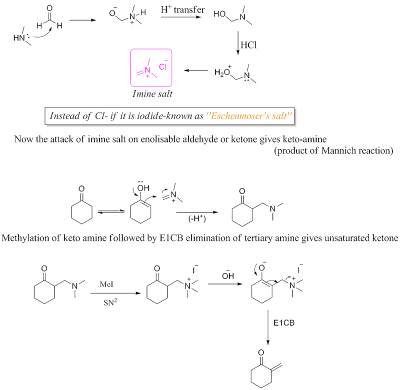Mannich reaction gives keto amines by reacting enolisable Carbonyl compound with formaldehyde and secondary amine.
It introduces dialkyl amino methyl group at alpha position of enolisable carbonyl compounds.
It involves condensation of enolisable Carbonyl compound with iminium ion.
Enolisable carbonyl compound + HCHO + secondary amine = keto amine
First we will talk about "Aldol reaction '' of enolisable aldehydes and ketones with formaldehyde. The biggest problem here is Formaldehyde-- Too reactive, really this is the problem. So, will see the product when acetaldehyde (enolisable) reacts with formaldehyde in presence of mild base.
Now we will see one conversion, the product is unsaturated ketone ( product of aldol condensation)
OK, shall we proceed via ''aldol condensation with formaldehyde" or ''Mannich'' reaction to get the above unsaturated ketone?
Vote goes to ''Mannich reaction'' ( Problem with formaldehyde so far we discussed.
NOW MANNICH REACTION
In the Mannich reaction imine salt forms from secondary amine and formaldehyde. The resulting imine salt attacks on enolisable aldehydes or ketones. By using Mannich reaction we can add only one molecule of HCHO to ketone or aldehyde.
--------------------------------------------------------------------------------------------------------------------------




















